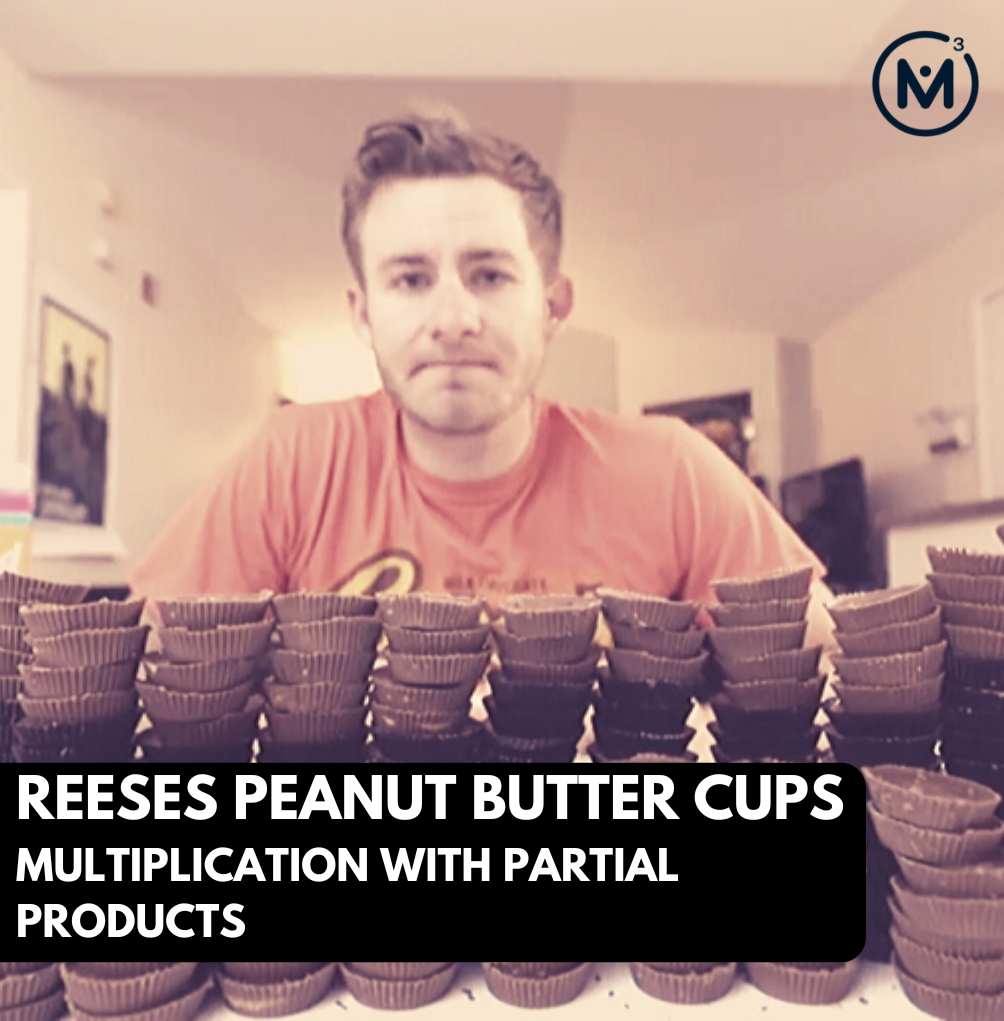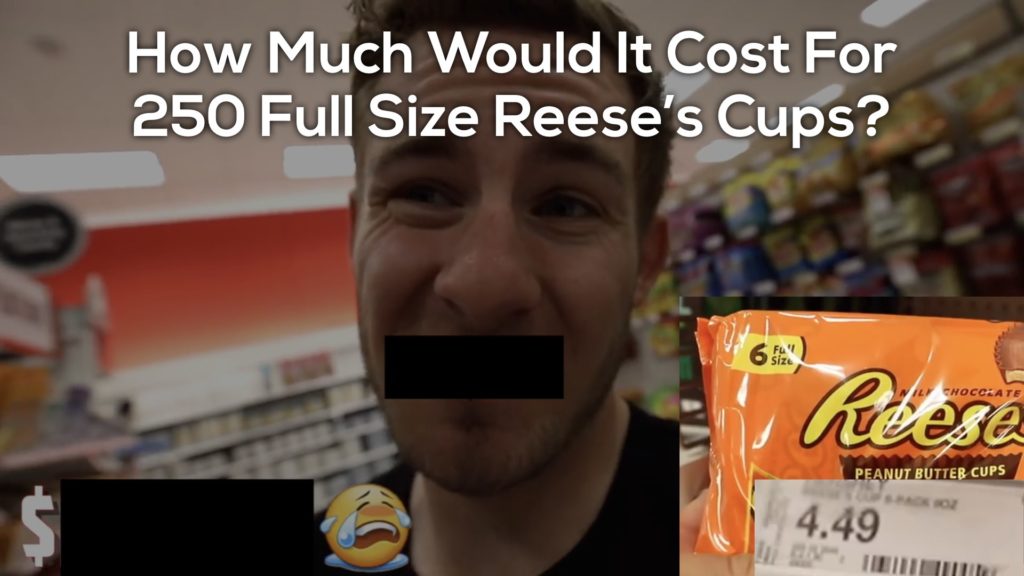REESES PEANUT BUTTER CUPS [DAY 3]
Multiplication with partial products
Decompose an array to reveal partial products in order to estimate a large quantity.
Intentionality
Spark Curiosity
Fuel Sensemaking
During Moves
Student Approaches
Next Moves
Consolidation
Reflect and Consolidation Prompts
Resources & Downloads
Educator Discussion Area
Intentionality & Unit Overview

Length of Unit: 5 Days
Access each lesson from this unit using the navigation links below
Students will determine the total cost for 250 Reese’s Peanut Cups through counting, additive and multiplicative thinking. Students will explore rate and ratio reasoning though this composed unit or Peanut Butter Cups and total cost in dollars.
In this task, students will have an opportunity to determine the total cost for 250 Peanut Butter Cups through ratio reasoning or rate reasoning. Students might use counting, repeated addition or multiplication to scale the composed unit in tandem through ratio reasoning. Students might also use rate reasoning and multiply the number of Peanut Butter cups by the rate.
Some big ideas that will be explored in the following task include:
- Unitizing;
- Ratio reasoning through scaling in tandem;
- The relationship between repeated addition and multiplication;
- A composed unit is one way of defining the relationship that exists in a ratio.
- Numbers can be composed and decomposed.
- The distributive property of multiplication over addition and subtraction.
- When you multiply a number by the base, the digits shift one place to the left.
- There is a constant multiplicative comparison that exists between two quantities in any ratio that is derived from the same rate.
Spark Curiosity
What Do You Notice? What Do You Wonder?
Show students the video below where they will see Erik purchasing the Reese’s Peanut Butter Cups at target. 6 regular size Reese’s Peanut Butter Cups for $4.49. Ask students to share everything they Notice and Wonder. Ask students to engage in a notice and wonder protocol. ANYTHING and EVERYTHING that comes to mind is fair game. Write down all of the students’ noticing and wondering. For example:- There are 6 in a pack.
- Each one is $4.49.
- He says he has to reconsider.
- Why did he say he has to reconsider?
- He went to Target.
- The basket is red.
- How much would it cost?
- And many others…
Fuel Sense-making
Crafting A Productive Struggle: Prompt
Share the PROMPT question:
How Much Does It Cost for 250 Regular Size Reese’s Peanut Butter Cups?
This task can be used to explore multiplying decimals to hundredths by whole numbers as well as scaling composed units in tandem. Exploring the distributive property over addition and subtraction will be helpful when reasoning through this task. Students might approach this multiplication using partial products. Students might consider representing their thinking on a double number line or in a ratio table. On the double number line or in the ratio table, students might consider doubling and multiplying by 10.
During Moves
While Students Are Productively Struggling…
Login/Join to access the entire Teacher Guide, downloadable slide decks and printable handouts for this lesson and all problem based units.
Student Approaches
Student Approach #1: Double Number Line Using Ratio Reasoning
Login/Join to access the entire Teacher Guide, downloadable slide decks and printable handouts for this lesson and all problem based units.
Student Approach #2: Ratio Table Using Ratio Reasoning
Login/Join to access the entire Teacher Guide, downloadable slide decks and printable handouts for this lesson and all problem based units.
Student Approach #3: Double Number Line Using Quotative Division
Login/Join to access the entire Teacher Guide, downloadable slide decks and printable handouts for this lesson and all problem based units.
Next Moves
Reveal
Play the REVEAL video below so students can see the total cost for 250 Reese’s Peanut Butter Cups.
ANSWER: $208.33
After students check their result with the actual cost, they might be left wondering:
Why didn’t the cost I worked out match the cost Erik paid at the store?
Give students an opportunity to discuss with their table groups what might be going on and then share out.
If no students come up with sales tax as the culprit, you can help them out with that and possibly explore what the sales tax must have been as a percentage.
Consolidation
Login/Join to access the entire Teacher Guide, downloadable slide decks and printable handouts for this lesson and all problem based units.
Reflect and Consolidation Prompts
Provide students an opportunity to reflect on their learning by offering these consolidation prompts to be completed independently.
Consolidation Prompt #1:
Login/Join to access the entire Teacher Guide, downloadable slide decks and printable handouts for this lesson and all problem based units.
Consolidation Prompt #2:
Login/Join to access the entire Teacher Guide, downloadable slide decks and printable handouts for this lesson and all problem based units.
We suggest collecting this reflection as an additional opportunity to engage in the formative assessment process to inform next steps for individual students as well as how the whole class will proceed.
Resources & Downloads
Login/Join to access the entire Teacher Guide, downloadable slide decks and printable handouts for this lesson and all problem based units.
Educator Discussion Area
Login/Join to access the entire Teacher Guide, downloadable slide decks and printable handouts for this lesson and all problem based units.
Explore Our 60+ Problem Based Units
This Make Math Moments Lesson was designed to spark curiosity for a multi-day unit of study with built in purposeful practice, number talks and extensions to elicit and emerge strategies and mathematical models.
Dig into our other units of study and view by concept continuum, grade or topic!




